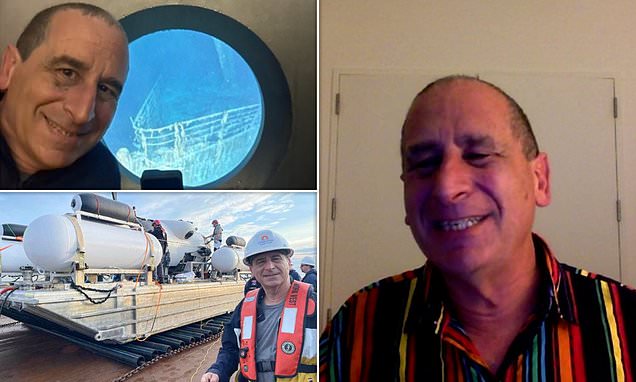Former Titanic sub tourist and Simpsons writer reveals expedition waiver he signed listed ‘three ways to die on page one’ and that he is ‘not optimistic’ about rescue mission
- Mike Reiss, a producer and writer on The Simpsons, travelled on Titan in 2022
- The submersible went down at 8am on Sunday; it has 40 hours of oxygen left
- Titanic tourist submarine missing LIVE: Coast Guard STILL haven’t located sub
A former passenger on the missing Titanic tourist submersible said he prepared himself to never get off the vessel after signing a waiver which listed ‘three ways to die on page one’.
Mike Reiss, who made his money as a producer and writer on The Simpsons, revealed that he is ‘not optimistic’ about the rescue of the five passengers on the sub, which has been missing since 9.45am on Sunday.
There are five people onboard Titan; tourists Hamish Harding, 58, Shahzada Dawood, 48, and his son Sulaiman Dawood, 19, French Navy pilot Paul-Henry (PH) Nargeolet and OceanGate CEO Stockton Rush.
Mr Reiss was one of just a handful of people who have ever been on the exclusive expedition to the bottom of the ocean, joining a crew on OceanGate Inc’s sub last year to tour the doomed ship.
He said of the five passengers currently on Titan: ‘I just feel for these people, my hopes are with them. I am not optimistic, I know how tiny the vessel is and how huge the ocean is’.
Mike Reiss, who was a producer and writer on The Simpsons, revealed that he is ‘not optimistic’ about the rescue of the five passengers on the Titan sub
‘I got on the sub and at the back of my mind was “well, I may never get off this thing,” that’s always with you,’ he added.
Speaking to the BBC today, Mr Reiss revealed he has been on three separate dives including the one to the Titanic and that each had ‘lost communication’.
He also detailed the experience of being onboard the luxury submersible, which tourists fork out $250,000 to travel on to the wreckage.
‘The experience going down was very relaxing, it’s a beautifully-designed submarine that feels almost spa-like on the inside. So even though there’s five people just sitting on the floor of something that’s about the size of a minivan it’s very comfortable.
‘I fell asleep on the way down it’s 2.5 hours of just dropping in the very quiet and there is a porthole but all you see is blackness.’
He said even though they made it to within 500 metres of the Titanic, the sub had to spend ‘a good 90 minutes just doing a random walk on the bottom of the ocean, just flailing around and trying to find the biggest boat in the world’.
The passengers on his expedition only had a short amount of time to see what he described as the ‘highlights’ of the world famous wreck.
‘Twenty minutes before we had to resurface we finally saw the Titanic and I have to say it was just enough in our case for a highlights tour, we looked at the anchor, looked at the porthole, looked at the bow of the ship and then we had to go back up.
‘It shows you the unpredictability of it all. The next day they sent another 5 passengers down to see it and they circled it and got to see every inch of it.
Mr Reiss detailed the experience of being onboard the submersible, which tourists fork out $250,000 to travel on to the wreckage
The Titan sub submerged at 8am on Sunday morning around 400 miles southeast of St John’s, Newfoundland, according to the US Coast Guard. It lost contact at 9.45am but it wasn’t reported to the Coast Guard until 5.40pm
French Navy veteran PH Nargeolet (left) is believed to be taking part in the expedition, along with Stockton Rush (right), CEO of the OceanGate Expedition
Among those taking part in the expedition is billionaire Hamish Harding (pictured), CEO of Action Aviation in Dubai. He excitedly posted to social media about being there on Sunday
Shahzada Dawood, 48, (pictured with his wife Christine) a UK-based board member of the Prince’s Trust charity, and his son Sulaiman Dawood, 19, are amongst the five people missing in the submarine that set off to see the wreck of the Titanic, it was revealed today
The company has taken tourists to the site since 2021, and Mr Reiss was one of a number of groups who made the perilous journey last year.
‘Somehow there’s just the acceptance of it [the risk].
‘This is why I have this sympathy for the people on board the sub, that they’re not panicking, that they knew what they were getting into.’
He said the ‘They built this beautiful submarine which can go where no other vessel can go, so if in the worst case they are down at the bottom of the ocean I can’t see how anyone will be able to get to them, much less rescue them.
At a press conference at the US Coast Guard Station in Boston – which is coordinating the search and rescue effort – First District Response Coordinator Capt. Jamie Frederick said it was not certain the sub could be saved – even if it is found today
The Titan submersible has been missing since 9.45am on Sunday morning after being launched into the Atlantic at 8am.
There are five people onboard including three wealthy tourists. The submersible’s oxygen supply for the five people on board is now just 40 hours.
At 12,500ft underwater, there are few vessels able to dive deeply enough to find it.
The only ones able to search the ocean floor are remotely operated vehicles which are searching the ocean now.
TIMELINE OF MISSING SUBMERSIBLE TITAN
8am Sunday: Titan submerges around 900 miles east of Cape Cod
9.45am: Polar Prince expedition ship loses contact with the submersible
5.40pm: Coast Guard first alerted to the missing sub
9.13pm: Canadian Coast Guard alerted
Thursday at 8am: 96 hours of oxygen runs out
If they find the sub, getting it to the surface is another feat entirely, requiring specialist equipment that is not yet on-site.
Other experts likened it to requiring a 2.5mile long cable to lasso to the far side of the moon.
There are multiple civilian ships assisting in the search, along with US Navy, Canadian Navy ships and aircraft.
Among pieces of equipment now on the way to the site is a decompression chamber for the five passengers, should they be brought to the surface.
‘Getting salvage equipment on-scene is a top priority,’ Frederick said.
The logistical challenge is immense; the Titanic wreck is situated some 400 miles southeast of St Johns, Newfoundland – around 900 miles east of Cape Cod.
At a press conference at the US Coast Guard Station in Boston – which is coordinating the search and rescue effort – First District Response Coordinator Capt. Jamie Frederick said it was not certain the sub could be saved – even if it is found today.
‘Even with that amount of time left, if you were to find the submersible at this moment, would that give you enough time to save those five people on board?’ he was asked.
‘I don’t know the answer to that question… all I know is we will do everything within our power to effect a rescue,’ Frederick replied.
The Coast Guard has already searched 7,600 square miles of ocean – a search area the size of Connecticut.
The 21ft submersible has an oxygen supply of up to 96 hours
The search site is some 900 miles off the coast of Cape Cod, 400 miles southeast of Newfoundland. Getting there is a difficult enough feat without finding the missing sub beneath the ocean surface
A Canadian Coast Guard cutter is expected to arrive at the search area this evening.
It takes several days for Coast Guard ships to reach the site from the US. In addition to the underwater remote operated vehicles and Coast Guard ships, several aircraft are surveying the water for any signs of the sub on the surface.
‘We don’t want to exhaust one possibility in place of another.
‘We don’t want to rule out that it is on the surface.
‘If it is on the surface we are fairly certain we will be able to find it,’ a Coast Guard official said, adding it is ‘impossible’ to say if it’s more likely it is on the surface or beneath it.
DailyMail.com previously revealed it took OceanGate eight hours to report the submersible as missing.
The company has not yet explained why it took so long to raise the alarm.
Source: Read Full Article













